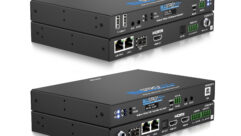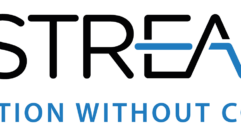

SVC: Let’s start with InfoComm. What did you show?
Gabi: There were a couple of major products we showed and announced. We showed for the first time how to extend over a single cable, single link, HDMI 2.0, 4K 60 4:4:4 or HDR content. So far it hasn’t been available. If a customer or a vendor wanted to implement such a solution, he either went to much deeper compression methods or he had to use two different cables to get it uncompressed.
With the new Reference design we have created, customers can enjoy the benefits and the quality of 4K60 4:4:4 in HDR over a single link with a visually lossless compression with almost very little—up to a 100 microsecond—of latency. So that’s the first product we are announcing. The other one is very interesting. It’s the availability of HDBaseT-IP solution. Basically allowing customers and installers to build a more complex network topology; a hybrid topology that will be enabling the use and leveraging the existing HDBaseT inside a meeting room and interconnecting it between different rooms and creating a complex, maybe a campus-level A/V distribution solution over Ethernet/IP network.
So these two new announcements are going to be very, very interesting, I believe. In addition we hosted actually 13 different members of the Alliance under the HDBaseT zone. So when people came to our booth they were able to see not only the two products I mentioned earlier, but also different vendors, different members of the Alliance showcasing their great products.
And then in our HDBaseT Installer Expert course, Daniel Schwartzberg presented the two products I mentioned earlier as well as the HDBaseT Expert Installer program. In these sessions we discussed and showcase how to do the best HDBaseT implementation in real-life applications. The session was sold out before the show.
I wanted to ask about the power capability. Where are we now with Power over HDBaseT? Are we still at 100 watts on that?
Gabi: So already today we are at 100 watts and we call it Power over HDBaseT. In near future, as you may know, under the IEEE there is an 802.3bt standard activity ongoing, which is about to match that power for roughly 100 watts. So once this is available and refined we will converge into the same so we will be compatible and interoperable.
In different cases we do have – we have demonstrated custom applications where we had to deliver 150 watts and even 250 watts into different applications. The HDBaseT technology is very robust and the error handling allows us to sustain higher power over these four twisted pairs as opposed to other technologies. Therefore we are able to do higher power levels.
There’s also an interesting cable certification program that we’re doing together with UL and I think that’s going to help a lot. It will allow to, I will say, converge traditional audio/video distribution with lighting, for example Video or Audio distribution with LED lighting – and other ideas around it. So UL and HDBaseT Alliance have jointly created a program to certify cables and to allow a wider usage of that technology. UL actually had a dedicated session about this during InfoComm and also at our booth as well.
If a company is planning to use HDBaseT technology in their upcoming product lines how do they become a member of the Alliance?
Tzahi: Joining the Alliance is quite a simple process. They can reach out to our admin department and we will have a representative at the Alliance booth on the floor. Basically it’s just executing a few short membership agreements and paying the membership fee and that’s it.
We have several membership levels. The ones that are publicly open are the adopter level and the contributor level. The contributor level is the more advanced level of membership that actually allows you to take part in the different working groups in the Alliance including the A/V working group which promotes and actually writes the specifications for such abilities as Gabi mentioned before, the HDBaseT A/V and the 4K 60 4:4:4. So this enables companies to be the first or to know in advance about the different features and capabilities of HDBaseT and also be able to influence them and take part in progressing and advancing the standard.
And when manufacturers want to get their products HDBaseT certified what’s the general process for that?
Tzahi: We see certification as an important part of the HDBaseT standard, and it’s important to make sure that all the products can interoperate with one another. So we have an authorized facility for conducting this certification and all HDBaseT Alliance members are able to open a certification request online, submit all the forms and all the information, and then send the product to the certification facility and have it certified in a few weeks after it arrives to the facility. I think one of the important things I want to mention about the certification process is that we have a process of certifying similar products for a very reduced cost which allow vendors that basically have the same HDBaseT design in several products to certify them without shipping the product to the certification center and for a very, very reduced cost.
Do people come up and give you stories about their HDBaseT installations? What kinds of things do you hear?
Gabi: Yes, all the time. Through our web site – the Alliance web site and Valens – we are publishing interesting use cases. We have a lot of case studies. And at the tradeshows we present on the big screens interesting case studies that we have collected throughout the year.
What’s the next big step for HDBaseT technology?
Gabi: The future is going to expand more on the networking capabilities and networking, meaning being able to do more complex topologies and being able to interconnect the audio/video solution systems at a campus. So HDBaseT-IP is the first type of this. Along with it you have the native HDBaseT networking solutions, what we call HDBaseT Switch. We truly allow, at the end of the day, a very cost-effective and yet best performing video distribution solution where you have within the room a pure HDBaseT network that gets the best effective high-quality video and interconnects that HDBaseT island to another HDBaseT island over the infrastructure of the IP using the HDBaseT-IP.
So it’s a bigger vision that we’re building, where we have both HDBaseT network and HDBaseT over IP—an HDBaseT-IP network. Also we want to maintain our leadership in the uncompressed distribution system so we will be able to do HDMI 2.0, 4K 60 4:4:4 using an uncompressed PHY. So this is a next-generation product coming from Valens. We will also open the door for using lite compression versions that support HDMI 2.1 for a successful ramp up in the near future, in maybe the next year and a half.










